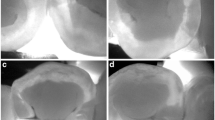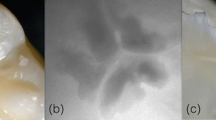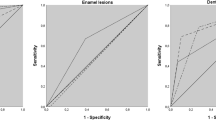Abstract
The objective of this clinical study was to compare conventional caries detection techniques, pen-type laser fluorescence device, and near-infrared light transillumination method in approximal dentin caries lesions. The study included 157 patients, aged 12–18, without any cavity in the posterior teeth. Two calibrated examiners carried out the assessments of selected approximal caries sites independently. After the assessments, the unopened sites were excluded and a total of 161 approximal sites were included in the study. When both the examiners arrived at a consensus regarding the presence of dentin caries, the detected lesions were opened with a conical diamond burr, the cavity extent was examined and validated (gold standard). Sensitivity, specificity, negative predictive value, positive predictive value, accuracy, and area under the ROC curve (Az) values among the caries detection methods were calculated. Bitewing radiography and near-infrared (NIR) light transillumination methods showed the highest sensitivity (0.83–0.82) and accuracy (0.82–0.80) among the methods. Visual inspection showed the lowest sensitivity (0.54). Laser fluorescence device and visual inspection showed nearly equal performance. Near-infrared light transillumination can be used as an alternative method to approximal dentin caries detection. Visual inspection and laser fluorescence device alone should not be used for approximal dentin caries.

Similar content being viewed by others
References
Anttonen V, Seppä L, Hausen H (2003) Clinical study of the use of the laser fluorescence device DIAGNOdent for detection of occlusal caries in children. Caries Res 37:17–23
Biesbrock A, Chesters R, Ellwood R, Smith S (2004) The challenges of validating diagnostic methods relative to a conventional two-year caries clinical trial. J Dent Res 83:C53–C55
Manton D (2013) Diagnosis of the early carious lesion. Aust Dent J 58:35–39
Maia A, Karlsson L, Margulis W, Gomes A (2014) Evaluation of two imaging techniques: near-infrared transillumination and dental radiographs for the detection of early approximal enamel caries. Dentomaxillofac Radiol 40:429–433
Celiberti P, Leamari V, Imparato J, Braga M, Mendes F (2010) In vitro ability of a laser fluorescence device in quantifying approximal caries lesions in primary molars. J Dent 38:666–670
Tassery H, Levallois B, Terrer E, Manton D, Otsuki M, Koubi S, Gugnani N, Panayotov I, Jacquot B, Cuisinier F (2013) Use of new minimum intervention dentistry technologies in caries management. Aust Dent J 58:40–59
Aktan AM, Cebe MA, Çiftçi ME, Karaarslan EŞ (2012) A novel LED-based device for occlusal caries detection. Lasers Med Sci 27:1157–1163
Pretty IA (2006) Caries detection and diagnosis: novel technologies. J Dent 34:727–739
Teo TK-Y, Ashley PF, Louca C (2014) An in vivo and in vitro investigation of the use of ICDAS, DIAGNOdent pen and CarieScan PRO for the detection and assessment of occlusal caries in primary molar teeth. Clin Oral Investig 18:737–744
Aoki A, Takasaki AA, Nagai S, Yoshida I, Zeredo JL, Mizutani K, Sasaki KM, Schwarz F, Eguro T, Izumi Y (2008) Current status of clinical laser applications in periodontal therapy. Gen Dent 56:674–687
Stabholz A, Zeltser R, Sela M, Peretz B, Moshonov J, Ziskind D (2003) The use of lasers in dentistry: principles of operation and clinical applications. Compend Contin Educ Dent 24:935–948
Nazemisalman B, Farsadeghi M, Sokhansanj M (2015) Types of lasers and their applications in pediatric dentistry. J Lasers Med Sci 6:96–101
Abogazalah N, Ando M (2017) Alternative methods to visual and radiographic examinations for approximal caries detection. J Oral Sci doi. doi:10.2334/josnusd.16-0595
Söchtig F, Hickel R, Kühnisch J (2014) Caries detection and diagnostics with near-infrared light transillumination: clinical experiences. Quintessence Int 45:531–538
Marinova-Takorova M, Panov V, Anastasova R (2016) Effectiveness of near-infrared transillumination in early caries diagnosis. Biotechnol Biotechnol Equip 30:1207–1211
Ando M, van Der Veen MH, Schemehorn BR, Stookey GK (2001) Comparative study to quantify demineralized enamel in deciduous and permanent teeth using laser- and light-induced fluorescence techniques. Caries Res 35:464–470
Diniz MB, Eckert GJ, González-Cabezas C, Cordeiro Rde C, Ferreira-Zandona AG (2016) Caries detection around restorations using ICDAS and optical devices. J Esthet Restor Dent 28:110–121
Javed F, Romanos GE (2015) A comprehensive review of laser-based systems used in early detection of dental caries. Stoma Edu J 2:106–111
Achilleos EE, Rahiotis C, Kakaboura A, Vougiouklakis G (2013) Evaluation of a new fluorescence-based device in the detection of incipient occlusal caries lesions. Lasers Med Sci 28:193–201
Lussi A, Hibst R, Paulus R (2004) DIAGNOdent: an optical method for caries detection. J Dent Res 83:C80–C83
Tomczyk J, Komarnitki J, Zalewska M, Lekszycki T, Olczak-Kowalczyk D (2014) Fluorescence methods (VistaCam iX proof and DIAGNODent pen) for the detection of occlusal carious lesions in teeth recovered from archaeological context. Am J Phys Anthropol 154:525–534
Lussi A, Hack A, Hug I, Heckenberger H, Megert B, Stich H (2006) Detection of approximal caries with a new laser fluorescence device. Caries Res 40:97–103
Lussi A, Hellwig E (2006) Performance of a new laser fluorescence device for the detection of occlusal caries in vitro. J Dent 34:467–471
Abdelaziz M, Krejci I (2014) DIAGNOcam—a near infrared digital imaging transillumination (NIDIT) technology. Int J Esthet Dent 10:158–165
Kühnisch J, Söchtig F, Pitchika V, Laubender R, Neuhaus KW, Lussi A, Hickel R (2015) In vivo validation of near-infrared light transillumination for interproximal dentin caries detection. Clin Oral Investig 20:821–829
Ekstrand KR, Ricketts DN, Kidd EA (1997) Reproducibility and accuracy of three methods for assessment of demineralization depth of the occlusal surface: an in vitro examination. Caries Res 31:224–231
Manji F, Fejerskov O, Baelum V (1989) Pattern of dental caries in an adult rural population. Caries Res 23:55–62
Huth K, Lussi A, Gygax M, Thum M, Crispin A, Paschos E, Hickel R, Neuhaus K (2010) In vivo performance of a laser fluorescence device for the approximal detection of caries in permanent molars. J Dent 38:1019–1026
Menem R, Barngkgei I, Beiruti N, Al Haffar I, Joury E (2017) The diagnostic accuracy of a laser fluorescence device and digital radiography in detecting approximal caries lesions in posterior permanent teeth: an in vivo study. Lasers Med Sci 32:621–628
Melo M, Pascual A, Camps I, Del Campo Á (2015) In vivo study of different methods for diagnosing pit and fissure caries. J Clin Exp Dent 7:e387–e391
Ekstrand K, Zero DT, Martignon S, Pitts NB (2009) Lesion activity assessment. Monogr Oral Sci 21:63–90
Viera AJ, Garrett JM (2005) Understanding interobserver agreement: the kappa statistic. Fam Med 37:360–363
Florkowski CM (2008) Sensitivity, specificity, receiver-operating characteristic (ROC) curves and likelihood ratios: communicating the performance of diagnostic tests. Clin Biochem Rev 29:S83–S87
Zhu W, Zeng N, Wang N (2010) Sensitivity, specificity, accuracy, associated confidence interval and ROC analysis with practical SAS implementations. NESUG proceedings: health care and life sciences, Baltimore, Maryland:1–9
Ricketts D, Kidd E, Weerheijm K, Soet H (1997) Hidden caries: what is it? Does it exist? Does it matter? Int Dent J 47:259–265
Marinova-Takorova M, Anastasova R, Panov VE (2014) Comparative evaluation of the effectiveness of five methods for early diagnosis of occlusal caries lesions-in vitro study. J of IMAB 20:533–536
Young D (2001) New caries detection technologies and modern caries management: merging the strategies. Gen Dent 50:320–331
Author information
Authors and Affiliations
Corresponding author
Ethics declarations
Conflict of interest
The authors declare that they have no conflict of interest.
Role of funding source
There is no source of funding.
Ethical approval
This study has been approved by the appropriate institutional and/or national research ethics committee and has been performed in accordance with the ethical standards as laid down in the 1964 Declaration of Helsinki and its later amendments or comparable ethical standards.
Informed consent
Informed consent was obtained from all individual participants included in the study.
Rights and permissions
About this article
Cite this article
Ozkan, G., Guzel, K.G.U. Clinical evaluation of near-infrared light transillumination in approximal dentin caries detection. Lasers Med Sci 32, 1417–1422 (2017). https://doi.org/10.1007/s10103-017-2265-z
Received:
Accepted:
Published:
Issue Date:
DOI: https://doi.org/10.1007/s10103-017-2265-z




